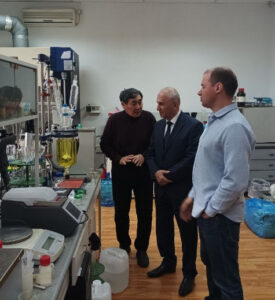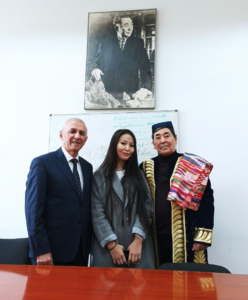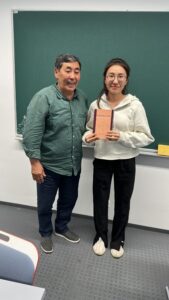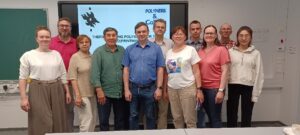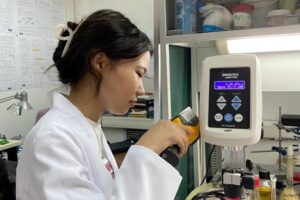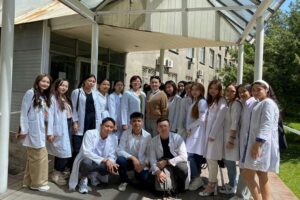In April 2024, the Institute of Polymer Materials and Technologies was visited by the head of the Department of Physical Chemistry of the National University of Uzbekistan named after Mirzo Ulugbek, Professor Hamdam Akbarov. He got acquainted with the scientific direction of the Institute and the available equipment. An agreement was reached on cooperation in the field of physical chemistry of polymers.
Ours in Europe
As part of the European Program for Science and Innovation “Horizon 2020”, a number of employees of the Institute of Polymer Materials and Technologies were at the University of Helsinki from June 1 to July 6, 2023. At the Faculty of Chemistry, Prof. Kudaibergenov S.E. gave an hour-long lecture on the topic: “Polyampholytes: Past, Present, Perspectives,” which aroused keen interest of the audience. After finishing the lecture, Prof. Kudaibergenov S.E. donated his monograph “Polyampholytes: Past, Present, Perspectives”, published in 2021 in Kazakhstan, to the library of the Faculty of Chemistry of the University of Helsinki and doctoral student of the University of Reading (England) Man Fei Fu.
According to tradition, two respected professors of the University of Helsinki (Heikki Tenhu and Vladimir Aseev) were dressed in Kazakh national clothes – shapan.
The Kazakh delegation took part in the mini-seminar “NANOPOL”, dedicated to the synthesis and research of special-purpose polymers with the report “Temperature and salt responsive amphoteric nanogels with immobilized methyl orange and methylene blue and study of dye release kinetics as a function of temperature and ionic strength”. Scientists and specialists from England, Germany, Kazakhstan, Russia, Finland and France took part in the seminar.
Scientific and production practice of chemistry students of Abai KazNPU on the basis of IPMT
3rd year students of Abay KazNPU with a specialty “6B05301-Chemistry” took part in summer research and production practice at the Institute of Polymer Materials and Technologies. They familiarized themselves with the available equipment and conducted research on the physicochemical properties of water-soluble and water-swellable polymers. The students’ practice was supervised by employees of the Institute G.S. Tatykhanova and N.N. Gizatullina.
For details, see the website: https://www.kaznpu.kz/ru/29313/news/
Internship at the University of Helsinki
In April-May 2024, two young employees of the Institute, Tuleyeva Rysgul and Gizatullina Nargiza, completed a two-month internship at the Laboratory of Colloidal and Polymer Chemistry at the University of Helsinki. Their work was conducted under the guidance of Associate Professor Vladimir Olegovich Aseev. During their internship, they focused on the modification of natural polysaccharides, specifically gellan and chitosan, to create polyampholytes. These polyampholytes were designed to stabilize gold nanoparticles for use in the photothermal therapy of cancer cells. The modification products of gellan and chitosan were thoroughly analyzed using dynamic laser light scattering, proton NMR spectroscopy, and transmission electron microscopy.
A quarter century in science
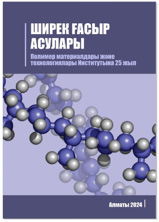 This year marks the 25th anniversary of the first private research institution in Kazakhstan, the Institute of Polymer Materials and Technologies, which was established on January 14, 1999. The sole founder of the Institute is Doctor of Chemical Sciences, Professor, and Laureate of the State Prize of the Republic of Kazakhstan, Kudaibergenov Sarkyt Elekenovich. The Institute’s primary mission is the development of specialty polymers for various applications, including environmental protection, the oil industry, biotechnology, nanotechnology, medicine, and catalysis. These polymers are essential in advancing modern technologies. The publication titled “Ширек ғасыр асулары” (A Quarter Century of Achievements) highlights the Institute’s contributions to the field of polymer science, detailing its current activities and accomplishments over the past 25 years. Additionally, this publication covers completed projects, defended dissertations, and published works by the Institute’s staff throughout its history. (For details, see the attached PDF file).
This year marks the 25th anniversary of the first private research institution in Kazakhstan, the Institute of Polymer Materials and Technologies, which was established on January 14, 1999. The sole founder of the Institute is Doctor of Chemical Sciences, Professor, and Laureate of the State Prize of the Republic of Kazakhstan, Kudaibergenov Sarkyt Elekenovich. The Institute’s primary mission is the development of specialty polymers for various applications, including environmental protection, the oil industry, biotechnology, nanotechnology, medicine, and catalysis. These polymers are essential in advancing modern technologies. The publication titled “Ширек ғасыр асулары” (A Quarter Century of Achievements) highlights the Institute’s contributions to the field of polymer science, detailing its current activities and accomplishments over the past 25 years. Additionally, this publication covers completed projects, defended dissertations, and published works by the Institute’s staff throughout its history. (For details, see the attached PDF file).
Friends, colleagues, staff members and former students
Sole founders of the Institute
Together with young scientists of the Institute


